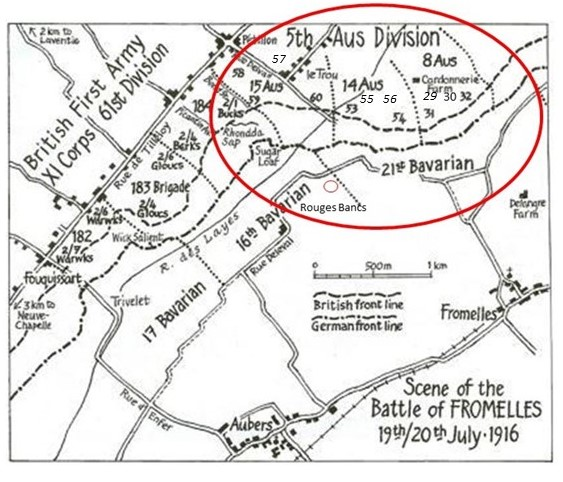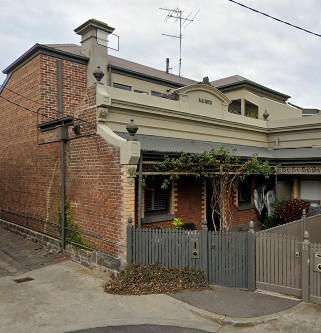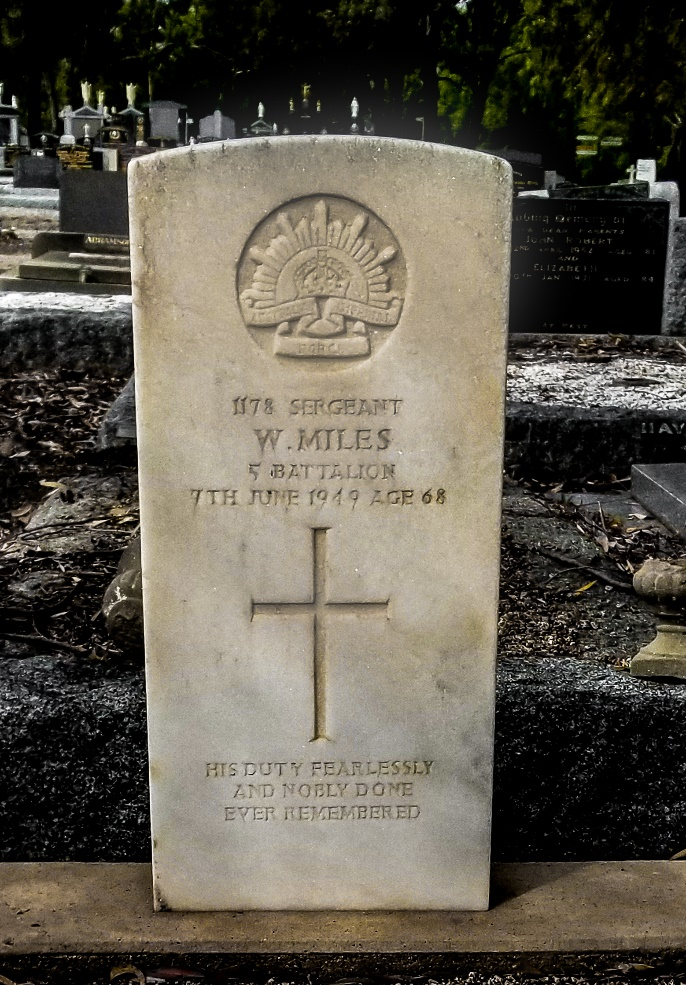
William MILES
Eyes Brown, Hair Black and Grey, Complexion Fair
“Billy” Miles – The Truce that Never Was
Early Life
William “Billy” Miles was born in April 1880 in Newport, Monmothshire, Wales to William and Elizabeth (Rees). He was the second of six children, three boys and three girls. Billy’s father was a lay preacher.
Billy began his soldiering career when he was about 20, heading to South Africa to fight in the Boer War. While he has listed his occupation as a Sailor, he served a year as a trooper/horseman in both Kitchener’s Fighting Scouts and Brabant’s Horse units in South Africa. He was with Kitchener’s Fighting Scouts in Durban from January 1901 and was assigned to B Troop, F Squadron in the 1st Battalion. His unit was constantly on the move. One of his mates, Corporal Albert Robinson, documented one of their days while in the Natal/NE area:
“Saturday, June 22nd Reveille 3:30 AM, moved off at 4:30 AM.
5 horses lost from lines at night. Horse Guard had to stay behind to find horses. We found all ours and several more at daylight. I found a fine big chestnut horse and called him Mack and kept him for myself. Gave Jim [old horse] to Miles, as his was done up.
Left flanking over very rough high hills, drifts, Rivers through very high grass and Prickly mimosa bush. Fine night, all quiet.”
To Australia
After serving in South Africa, Billy emigrated to Australia, arriving in Victoria in January 1903. In November he married Catherine Moore, who was from Collingwood, and they settled in Bendigo. Although he listed his occupation as a sailor on his enlistment form, he worked in a number of roles, from a clerk to a labourer to a carpet layer. Prior to WWI, the couple had three children.
Back to War
When the War broke out Billy was keen to serve again and enlisted on Australia Day 1915. However, during his early service he caught pneumonia and was discharged in July 1915 as medically unfit. But just a month later he was well enough and reenlisted and was assigned to D Company in the newly formed 29th Battalion. After a short period of training in Victoria, the 29th left Australia on 10 November 1915 on the A11 Ascanius. They arrived in Suez, Egypt on 7 December. Training continued until mid-June with postings at Ismailia, Tel el Kebir, Ferry Post and Moascar. While in Tel el Kebir in March, the troops were reviewed by the Prince of Wales.
The Western Front
The call to the Western front came in mid-June. On the 16th they boarded the troop ship Tunisian in Alexandria, heading to Marseilles, arriving there on the 23rd. They took the train to Hazebrouck and on to Steenbeque and by the 26th were encamped in Morbeque, about 30 km from Fleurbaix. On 1 July they moved to Hazebrouck. Training here included the use of gas masks for the possible use of “lachrymatory shells” – tear gas. Training was tough. One day included a march of 16 miles carrying 75 lb of kit, which only the youngest and fittest could complete. On 9 July they moved to Erquingham, just outside of Fleurbaix and on the 10th they got their first experience in the front line trenches. They were back in Fleurbaix on the 14th. There was a gas alarm on the 15th, but this was not felt by them in Fleurbaix.

The 29th’s role was to be a ‘fourth’ battalion on the left flank of the attack. With the 30th they were to provide support for the attacking 31st and 32nd Battalions by digging trenches, carrying supplies/ammunition and to be called in as reserves if needed for the fighting.
The original attack was planned for the 17th, but bad weather caused it to be postponed.
On 19 July the 29th were in the rear trenches, ready for the attack. The 32nd’s charge over the parapet began at 5:53 PM and the 31st’s at 5:58 PM. There were machine guns emplacements to their left and directly ahead at Delrangre Farm and there was heavy artillery fire in No-Man’s-Land. The initial assaults were successful and by 6:30 PM the Aussies were in control of the German’s 1st line system, which was described as:
“practically a ditch with from 1 to 2 feet of mud and slush at the bottom”.
By 8 PM the soldiers of the 29th were ready, with Billy’s D Company in the front trenches.
At 10 PM, additional support was being requested and C and D Companies joined in, carrying supplies over No Man’s Land. Unfortunately, they found that a number of the grenades they were carrying had no fuses. A German counterattack began at 2 AM and A and D Companies were drawn into the fighting. B and C Companies were also engaged, continuing to carry supplies and providing cover for soldiers who were retiring from the battle, but as noted in the War Diaries:
“After a struggle, Germans content to stop at their own trench.”
The attack on their right was altered and they became exposed in a salient jutting into the German lines and were quickly enfolded by German machine guns. In the end, they basically had to fight their way back to their own lines, 'run for it', or be killed wounded or captured. Source 29th Battalion VWMA Httpsps://vwma.org.au/explore/units/111
In the morning the battle was over. The 29th were left to hold the front line and, even though a cease fire was not in effect, were busily bringing back a large number of wounded during the day and night. The nature of this battle was summed up by Private Jim Cleworth (784) from the 29th:
"The novelty of being a soldier wore off in about five seconds, it was like a bloody butcher's shop".
When bombardment ceased on the 20th, they reorganized and were busy holding their front line. For a battalion supposed to be in a support role, the initial figures of the impact of the battle on the 29th were 17 soldiers died, 161 were wounded and 68 were missing.
The Truce that Never Happened
Billy was a key figure in supporting his mates after the battle, as is well documented in several books. Garrie Hutchinson’s book, ‘Pilgrimage - A Traveller’s Guide to Australia’s Battlefields’ has a detailed account:
“After the guns had stopped, according to Charles Bean, ‘there was a stillness never again experienced by the 5th Division in the front trenches. The sight of the wounded lying tortured and helpless in no man’s land, within a stone’s throw of safety, but apparently without hope of it, made so strong and appeal that more than one Australian, taking his life
into his hands, went out to tend them.’
What followed, the truce that never happened, is an extraordinary story, best told in the words of Sergeant William ‘Billy’ Miles of the 8th Brigade (29th Battalion) an in a letter to Bean.” “On the afternoon of 20 July, Billy had volunteered to go out into no man’s land to tend to the wounded and look for Captain Ken Mortimer. ‘I offered and was given a Red Cross badge for my arm and over I went, landing in a shell hole and ricking my knee. I asked two or three wounded if they had seen Capt. Mortimer, but could not find him.’
After tending to some wounded men, dodging from shell hole to shell hole, Billy heard a voice. ‘I jumped as well as I could into another shell hole, which, however, was not deep enough to hide in, and heard someone call out from the German lines; looking over, I saw a man beckoning to me. I got up and walked slowly towards him, stopping once to pick up a pair of field glasses. I stopped at the edge of the wire.’
The following conversation took place with the officer Billy named Fritz (who spoke perfect English):
Fritz: What are you supposed to be doing?
Billy: Tending wounded men, giving them a drink, and cutting their equipment off so they will lie more comfortable till we can get them in.
Fritz: You may be laying wires, this is not the usages of war.
Billy: Oh yes it is, the Red Cross is always allowed to work unmolested.
Fritz: What did you pick up just now?
Billy: Pair of field glasses.
Fritz: It might have been a bomb.
Billy: I’ll show you.
Fritz: Don’t put your hands in your pocket, put your hands above your head.
Billy waited by the German wire as ‘Fritz’ spoke on the telephone to his superiors.”
“The German officer put down the telephone and Billy promptly asked whether he could lower his hands.
Fritz answered, ‘I forgot, your arms much be aching’. And then added, ‘I want you to go back to your lines and ask an officer to come over here and we will have a “parliamentaire” and see if we can arrange about collecting the wounded. Will you come back and let me know what they say?’
Billy promised and returned with Major Alex Murdoch, distributing water bottles as they walked across.
‘Fritz’ explained, according to Billy, that if an Australian officer would allow himself to be blindfolded and held as a hostage in the German trench, each side could collect the wounded in the half of no man’s land nearest them (Bean, in the official version has this as a suggestion from Murdoch.)
Murdoch and Miles returned to the Australian lines and asked General McCay for permission for this informal truce, while Australian stretcher-bearers were busy bringing in as many wounded men as they could, and the Germans were repairing their parapet and looking after their own wounded.
McCay refused Murdoch’s request for the truce, claiming instructions from higher headquarters were explicit and unambiguous.
In Bean’s words – “‘The horror of knowing that a mate – his living body the prey of flies and ants – is slowly being done to death within two minutes of the succour to which, without military disadvantage, he could be brought, is less present to distant staffs than to officers and men in the line, and was estimated (though doubtless only after severe internal conflict) as a trifle when balanced against the mighty issues at stake…’”
“There was no truce, but for the next three days and nights Australians went out into no man’s land under enemy fire to bring in the wounded.”
On the night of 20 July alone, more than 300 wounded from the 15th Brigade were brought in.
Simon Fraser, 15th Brigade, was also bringing the wounded in. As he was helping one soldier, he heard a cry from another: ‘Don’t forget me cobber!’ Simon was able to return and bring him back in safely.
Source: Our Darkest Day, Patrick Lindsay
Ultimately, 104 soldiers of the 29th Battalion were killed in action or died of wounds from the battle. From those missing and later declared as killed in action, to date (2023), 17 have been found at the Pheasant Wood burial site.
One Battle Over, But the War Goes On
While there were no further attacks at Fleurbaix, Billy’s Battalion remained, holding the line until 31 July, when they were relieved by 31st Battalion. They moved to Bac St Maur, not far from Fleurbaix and they finally evacuated trenches after 38 days. It took until 26th Sept to be able to get a hot bath. It was noted in the War Diaries that “the men were in good heart”. They went to Amentieres by “motor wagons” which were “very satisfying”. Source AWM4 23/46/14, 29th Battalion War Diaries, September 1916, page 2
Although the 29th Battalion still spent periods in the front lines, they did not play a major offensive role for the rest of the year. Billy was promoted to Lance Corporal in March 1917, Corporal in May 1917 and to Sergeant in Sept 1917. The one large battle in 1917 in which the 29th Battalion played a major role was Polygon Wood, fought in the Ypres sector in Belgium from 26 September to 3 October 1917. The battle began at 5:50 AM, under heavy bombardment of gas shells. By noon, they had achieved their objective, but the German counter attacks began at 2 PM. The six counter attacks that took place that night and into the next day were successfully repelled. The 29th Battalion was relieved late on September 27th.
Billy was wounded in this offensive, “shell shock”. He was sent to several hospitals in the area for treatment. He was not released to rejoin his unit until December 1917.
He was later transferred from the 29th. He and spent the rest of his time in Europe assigned to training brigades and administrative headquarters assignments, briefly in the 58th Battalion and finally to the 5th Battalion. He finally completed his service and was sent home to Australia in January 1919, arriving 27 February, 1919. He received his discharge on 13 April 1919. For his efforts in two major battles, he received the Victory Medal, the Star Medal and the British War Medal.
Back Home
Billy and Catherine Miles had another child after the war. They named the boy Aussie. They lived in a number of places, Bendigo, Mooroopna (near Shepparton) where Billy was an orchardist and finally in South Melbourne.
Billy died on 7 June, 1949, 69 years old. He was buried on 9 June 1949, in Fawkner Memorial Park, Melbourne. Catherine died in 1963.
The Fromelles Association would love to hear from you

Contacts
(Contact: royce@fromelles.info or geoffrey@fromelles.info).
(Contact: army.uwc@defence.gov.au or phone 1800 019 090).
Donations
If you are able, please contribute to the upkeep of this resource.
(Contact: bill@fromelles.info ).

